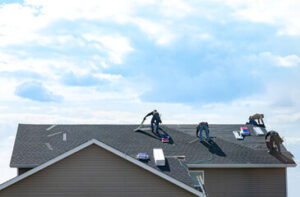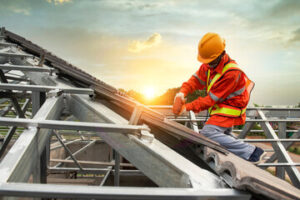Roof Replacement Erie PA is no longer just about changing old shingles. It now involves smart technologies and eco-friendly materials. These new elements enhance performance and longevity. Modern homes require roofing that adapts to change.

Today’s roof replacements focus on energy efficiency. Many materials reflect sunlight to reduce heat absorption. This lowers indoor temperatures without added cooling. Energy bills go down while comfort goes up.
Some roofing systems now come with integrated solar cells. These are built into the materials, not placed on top. They generate electricity directly from the surface. It saves space and blends in better visually.
Homeowners are also choosing green roofing options. These include recycled or plant-based components. Some even support vegetation growth. This reduces runoff and improves air quality.
Drones are becoming key tools in roof assessments. They capture detailed images before replacement begins. This reduces risks for inspectors. It also provides better data for decision-making.
Thermal scanning is also gaining popularity. It detects hidden moisture or insulation gaps. These insights guide what needs to be replaced. The result is a more efficient and targeted job.
Lightweight composite roofing is another rising trend. These materials mimic traditional ones but weigh less. They reduce structural load on older homes. They are also easier and faster to install.
Some roofing solutions now adjust to weather changes. Smart materials expand or contract with temperature shifts. This prevents cracks and leaks. Longevity improves through this adaptive feature.
Ventilation systems are being updated during replacements. Proper airflow prevents mold and heat buildup. Modern designs blend ventilation into the roofline. This supports aesthetics while boosting function.
Noise reduction is now a goal for some roof replacements. Special barriers can be installed underneath. These absorb outside sound like rain or traffic. It creates a more peaceful indoor environment.
Fire-resistant materials are becoming more standard. These help slow the spread of fire. It’s a safety upgrade that insurance firms favor. It also gives homeowners peace of mind.
Some homeowners use roof replacement to add skylights. This boosts natural lighting inside the house. It reduces the need for artificial lighting. It also improves mood and visibility.
Insulated panels are also being adopted widely. These panels combine roofing and insulation in one. It cuts down on layers needed. Installation is simpler and more cost-efficient.
The timing of roof replacements is also strategic now. Some homeowners align it with tax incentives. Others schedule it during mild seasons. This ensures faster work with fewer delays.
Robotic tools are also making their way into roofing. These machines handle repetitive tasks like nailing. It speeds up the process and lowers labor strain. Precision improves, and mistakes decrease.
Contractors are using apps to track progress in real time. Clients get updates without climbing ladders. These digital reports include photos and checklists. Communication becomes smoother and clearer.
Some replacement projects include gutter upgrades. This ensures the new roof works with proper drainage. Modern gutters reduce debris buildup. They are more efficient in directing water away.
Many homeowners are prioritizing aesthetics with roof designs. Colors and textures now match exterior décor. This adds value to the home’s appearance. Curb appeal increases significantly.
Roof replacement can also support attic conversions. By lifting or reshaping the roof, space is added. This new area can serve as a room or office. It adds living value without expanding the footprint.
Smart roof sensors are emerging in newer systems. They detect leaks, movement, or extreme weather. Early warnings prevent larger issues. This supports maintenance long after installation.
Replacements today also aim to reduce carbon footprints. Low-emission manufacturing is favored. This lessens the roof’s environmental impact. Sustainability becomes part of every decision.
Older homes need specialized roof replacements. Materials must match historical designs. Yet they also need modern durability. Skilled contractors blend both for lasting results.
Digital modeling helps homeowners visualize options. Before replacement starts, 3D views are provided. It builds confidence in design choices. Changes can be made easily before work begins.
Waterproof underlayment is now a standard practice. It serves as a secondary barrier under the surface. This adds protection against storms or leaks. It’s a small layer with big benefits.
Wind-resistant roofing is in high demand today. Interlocking materials resist being blown off. Anchoring methods are improved for safety. This is crucial in areas with frequent storms.
The rise of modular roofs is another innovation. These pre-built sections arrive ready to install. It reduces installation time significantly. Precision improves when pieces are factory-made.
Climate-adaptive materials are shaping roof choices. These adjust based on regional weather patterns. For hot zones, reflective coatings are key. For cold zones, insulation takes priority.
Some roof replacements include radiant heat systems. This is common in snowy regions. It melts snow before buildup occurs. It also prevents ice dams and related damage.
Acoustic insulation can be added under new roofs. It improves soundproofing inside the house. This is useful near airports or highways. Comfort improves beyond just weather control.
Digital warranties are also more common now. Clients receive lifetime guarantees with online access. They can track service history and updates. This simplifies future maintenance and claims.
For rental properties, roof replacements boost tenant satisfaction. They feel safer and more comfortable. It also increases the building’s rental value. Maintenance requests go down post-upgrade.
Some advanced systems support solar thermal collection. They use roof space to heat water. It supplements home heating needs. Energy savings grow beyond just electricity.
Environmental certifications are now tied to roofing choices. Certain materials qualify homes for green ratings. These influence property value and resale. They also reflect responsible ownership.
Storm preparation is often done with roof upgrades. Reinforced edges and anchors are added. These resist heavy rain and wind. It reduces the need for emergency repairs later.
Some homeowners choose cool roofs for urban heat relief. These roofs reflect more sunlight. They lower surrounding air temperatures. It’s a step toward community climate action.
Flexible roofing membranes are being used on complex structures. These bend and stretch without breaking. Ideal for curves or domes, they expand design possibilities. It also reduces joint stress.
New drainage layers are now being placed under roofs. These redirect trapped moisture safely. It prevents wood rot and mold formation. It adds to the structure’s long-term health.
Roofing systems are also getting smarter in design. Some include modular vents and access ports. This supports easier maintenance later. It also allows faster repairs when needed.
Modern roof replacement is as much about function as beauty. It’s no longer just a repair job. It is an upgrade in safety, comfort, and design. A smart roof adds long-term home value.
